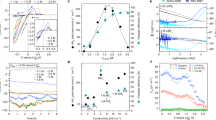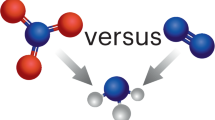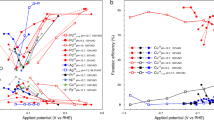Abstract
Ammonia is a chemical commodity in high demand, owing to its use in agriculture as well as its potential as a chemical vector for renewable energy storage and transportation. At present, ammonia synthesis consumes 1–2% of the world’s total energy output while producing 1% of the world’s total carbon emissions. Thus, the development of greener synthetic routes to ammonia is urgently required. In this Review, we discuss the progress and challenges in regard to the technological and economic aspects of various routes to green ammonia synthesis. Fundamental mechanisms, including the classical N2 dissociative process, the newly identified associative process for catalytic N2 conversion to NH3 under milder conditions and the chemical looping pathway, are discussed to guide novel catalyst designs. In particular, associative N2 activation can be achieved at low pressure, which is more adaptable for coupling to renewable energy (such as solar, wind or tidal), offering a new industrial production route to green ammonia. Additional possibilities for direct large-scale green ammonia synthesis through electrochemical and photochemical approaches are also discussed. Finally, a scaleup roadmap for ammonia synthesis is described alongside recent industrial developments, highlighting the rapid evolution and prosperous future of green ammonia generation.

This is a preview of subscription content, access via your institution
Access options
Subscribe to this journal
Receive 12 digital issues and online access to articles
$119.00 per year
only $9.92 per issue
Buy this article
- Purchase on Springer Link
- Instant access to full article PDF
Prices may be subject to local taxes which are calculated during checkout






Similar content being viewed by others
References
Bell, T. E. & Torrente-Murciano, L. H2 production via ammonia decomposition using non-noble metal catalysts: a review. Top. Catal. 59, 1438–1457 (2016).
Kojima, Y. Hydrogen storage materials for hydrogen and energy carriers. Int. J. Hydrog. Energy 44, 18179–18192 (2019).
Smith, C., Hill, A. K. & Torrente-Murciano, L.Current and future role of Haber–Bosch ammonia in a carbon-free energy landscape. Energy Environ. Sci. 13, 331–344 (2020).
Ravi, M. & Makepeace, J. W.Facilitating green ammonia manufacture under milder conditions: what do heterogeneous catalyst formulations have to offer. Chem. Sci. 13, 890–908 (2022).
Bañares-Alcántara, R. et al. Analysis of Islanded Ammonia-based Energy Storage Systems (Univ. Oxford, 2015).
Wang, Q., Guo, J. & Chen, P. Recent progress towards mild-condition ammonia synthesis. J. Energy Chem. 36, 25–36 (2019).
Ghavam, S., Vahdati, M., Wilson, I. A. G. & Styring, P. Sustainable ammonia production processes. Front. Energy Res. 9, 580808 (2021).
Bellenger, R., Darnajoux, X., Zhang, A. M. L. & Kraepiel, J. P. Biological nitrogen fixation by alternative nitrogenases in terrestrial ecosystems: a review. Biogeochemistry 149, 53–73 (2020).
Hywind Scotland (Equinor, 2022); https://www.equinor.com/energy/hywind-scotland
Offshore Solutions (Siemens Energy Global, 2022); https://www.siemens-energy.com/global/en/offerings/industrial-applications/oil-gas/offshore-solutions.html
Foster, S. L. et al. Catalysts for nitrogen reduction to ammonia. Nat. Catal. 1, 490–500 (2018).
Walter, M. D. Ammonia formation revisited. Nat. Chem. 14, 12–13 (2021).
Mortensen, J. J., Hansen, L. B., Hammer, B. & Nørskov, J. K. et al. Nitrogen adsorption and dissociation on Fe(111). J. Catal. 182, 479–488 (1999).
Ertl, G. Reactions at surfaces: from atoms to complexity. Angew. Chem. Int. Ed. 47, 3524–3535 (2007).
Qian, J., An, Q., Fortunelli, A., Nielsen, R. J. & Goddard, W. A. Reaction mechanism and kinetics for ammonia synthesis on the Fe(111) surface. J. Am. Chem. Soc. 140, 6288–6297 (2018).
Lin, R. J., Li, F. Y. & Chen, H. L. Computational investigation on adsorption and dissociation of the NH3 molecule on the Fe(111) surface. J. Phys. Chem. C 115, 521–528 (2011).
Egeberg, R. C. et al. N2 dissociation on Fe(110) and Fe/Ru(0001): what is the role of steps? Surf. Sci. 491, 183–194 (2001).
Medford, A. J. et al. From the Sabatier principle to a predictive theory of transition-metal heterogeneous catalysis. J. Catal. 328, 36–42 (2015).
Rod, T. H., Logadottir, A. & Nørskov, J. K. Ammonia synthesis at low temperatures. J. Chem. Phys. 112, 5343–5347 (2000).
Humphreys, J., Lan, R. & Tao, S. Development and recent progress on ammonia synthesis catalysts for Haber–Bosch process. Adv. Energy Sustain. Res. 2, 2000043 (2021).
Jacobsen, C. J. H. et al. Catalyst design by interpolation in the periodic table: bimetallic ammonia synthesis catalysts. J. Am. Chem. Soc. 123, 8404–8405 (2001).
Fang, H. et al. Challenges and opportunities of Ru-based catalysts toward the synthesis and utilization of ammonia. ACS Catal. 12, 3938–3954 (2022).
Arnaiz del Pozo, C. & Cloete, S. Techno-economic assessment of blue and green ammonia as energy carriers in a low-carbon future. Energy Convers. Manag. 255, 115312 (2022).
Sato, K. & Nagaoka, K. Boosting ammonia synthesis under mild reaction conditions by precise control of the basic oxide–Ru interface. Chem. Lett. 50, 687–696 (2021).
Sato, K. et al. Surface dynamics for creating highly active Ru sites for ammonia synthesis: accumulation of a low-crystalline, oxygen-deficient nanofraction. ACS Sustain. Chem. Eng. 8, 2726–2734 (2020).
Lin, B. et al. Morphology effect of ceria on the catalytic performances of Ru/CeO2 catalysts for ammonia synthesis. Ind. Eng. Chem. Res. 57, 9127–9135 (2018).
Marakatti, V. S. & Gaigneaux, E. M. Recent advances in heterogeneous catalysis for ammonia synthesis. ChemCatChem 12, 5838–5857 (2020).
Feng, J. et al. Sub-nanometer Ru clusters on ceria nanorods as efficient catalysts for ammonia synthesis under mild conditions. ACS Sustain. Chem. Eng. 10, 10181–10191 (2022).
Wu, S. et al. Removal of hydrogen poisoning by electrostatically polar MgO support for low-pressure NH3 synthesis at a high rate over the Ru catalyst. ACS Catal. 10, 5614–5622 (2020).
Wu, S. et al. Rapid interchangeable hydrogen, hydride, and proton species at the interface of transition metal atom on oxide surface. J. Am. Chem. Soc. 143, 9105–9112 (2021).
Kitano, M. et al. Ammonia synthesis using a stable electride as an electron donor and reversible hydrogen store. Nat. Chem. 4, 934–940 (2012).
Kitano, M. et al. Electride support boosts nitrogen dissociation over ruthenium catalyst and shifts the bottleneck in ammonia synthesis. Nat. Commun. 6, 6731 (2015).
Kammert, J. et al. Nature of reactive hydrogen for ammonia synthesis over a Ru/C12A7 electride catalyst. J. Am. Chem. Soc. 142, 7655–7667 (2020).
Wu, J. et al. Intermetallic electride catalyst as a platform for ammonia synthesis. Angew. Chem. Int. Ed. 58, 825–829 (2019).
Gong, Y. et al.LaRuSi electride disrupts the scaling relations for ammonia synthesis. Chem. Mater. 34, 1677–1685 (2022).
Zhang, X. et al. Synergizing surface hydride species and Ru clusters on Sm2O3 for efficient ammonia synthesis. ACS Catal. 12, 2178–2190 (2022).
García-García, F. R., Guerrero-Ruiz, A. & Rodríguez-Ramos, I. Role of B5-type sites in Ru catalysts used for the NH3 decomposition reaction. Top. Catal. 52, 758–764 (2009).
Shetty, S., Jansen, A. P. J. & Van Santen, R. A. Active sites for N2 dissociation on ruthenium. J. Phys. Chem. C 112, 17768–17771 (2008).
Wang, L., Chen, J., Ge, L., Rudolph, V. & Zhu, Z. Difference in the cooperative interaction between carbon nanotubes and Ru particles loaded on their internal/external surface. RSC Adv. 3, 12641–12647 (2013).
Li, L. et al. Size sensitivity of supported Ru catalysts for ammonia synthesis: from nanoparticles to subnanometric clusters and atomic clusters. Chem 8, 749–768 (2022).
Zhou, Y. et al. Unraveling the size-dependent effect of Ru-based catalysts on ammonia synthesis at mild conditions. J. Catal. 404, 501–511 (2021).
Zeinalipour-Yazdi, C. D., Richard, C., Catlow, A., Hargreaves, J. S. J. & Laassiri, S. A comparative analysis of the mechanisms of ammonia synthesis on various catalysts using density functional theory. R. Soc. Open Sci. 8, 210952 (2021).
Kojima, R. & Aika, K. I. Cobalt molybdenum bimetallic nitride catalysts for ammonia synthesis. Chem Lett. 29, 514–515 (2003).
Zeinalipour-Yazdi, C. D., Hargreaves, J. S. J., Richard, C. & Catlow, A. Low-T mechanisms of ammonia synthesis on Co3Mo3N. J. Phys. Chem. C 122, 6078–6082 (2018).
Zeinalipour-Yazdi, C. D., Hargreaves, J. S. J., Laassiri, S., Richard, C. & Catlow, A. The integration of experiment and computational modelling in heterogeneously catalysed ammonia synthesis over metal nitrides. Phys. Chem. Chem. Phys. 20, 21803–21808 (2018).
Ye, T.-N. et al. Vacancy-enabled N2 activation for ammonia synthesis on an Ni-loaded catalyst. Nature 583, 391–395 (2020).
Ye, T.-N. et al. Contribution of nitrogen vacancies to ammonia synthesis over metal nitride catalysts. J. Am. Chem. Soc. 142, 14374–14383 (2020).
Wang, Q. et al. Ternary ruthenium complex hydrides for ammonia synthesis via the associative mechanism. Nat. Catal. 4, 959–967 (2021).
Hattori, M., Iijima, S., Nakao, T., Hosono, H. & Hara, M. Solid solution for catalytic ammonia synthesis from nitrogen and hydrogen gases at 50 °C. Nat. Commun. 11, 2001 (2020).
Liu, J.-C. et al. Heterogeneous Fe3 single-cluster catalyst for ammonia synthesis via an associative mechanism. Nat. Commun. 9, 1610 (2018).
Zheng, J. et al. Efficient non-dissociative activation of dinitrogen to ammonia over lithium-promoted ruthenium nanoparticles at low pressure. Angew. Chem. Int. Ed. 58, 17335–17341 (2019).
Wang, X. et al. Atomically dispersed Ru catalyst for low-temperature nitrogen activation to ammonia via an associative mechanism. ACS Catal. 10, 9504–9514 (2020).
Ye, T.-N. et al. Dissociative and associative concerted mechanism for ammonia synthesis over Co-based catalyst. J. Am. Chem. Soc. 143, 12857–12866 (2021).
Zhou, Y. et al. Integrating dissociative and associative routes for efficient ammonia synthesis over a TiCN-promoted Ru-based catalyst. ACS Catal. 12, 2651–2660 (2022).
Lai, Q. et al. Chemical looping based ammonia production—a promising pathway for production of the noncarbon fuel. Sci. Bull. 67, 2124–2138 (2022).
Gao, W. et al. Production of ammonia via a chemical looping process based on metal imides as nitrogen carriers. Nat. Energy 3, 1067–1075 (2018).
Yan, H. et al. Lithium palladium hydride promotes chemical looping ammonia synthesis mediated by lithium imide and hydride. J. Phys. Chem. C 125, 6716–6722 (2021).
Yang, S. et al. Molybdenum-based nitrogen carrier for ammonia production via a chemical looping route. Appl. Catal. B Environ. 312, 121404 (2022).
Tagawa, K., Gi, H., Shinzato, K., Miyaoka, H. & Ichikawa, T. Improvement of kinetics of ammonia synthesis at ambient pressure by the chemical looping process of lithium hydride. J. Phys. Chem. C 126, 2403–2409 (2022).
Xiong, C. et al. High thermal stability Si–Al based N-carrier for efficient and stable chemical looping ammonia generation. Appl. Energy 323, 119519 (2022).
Pereira, R. J. L., Hu, W. & Metcalfe, I. S. Impact of gas–solid reaction thermodynamics on the performance of a chemical looping ammonia synthesis process. Energy Fuels 36, 9757–9767 (2022).
Jain, M., Muthalathu, R. & Wu, X. Y. Electrified ammonia production as a commodity and energy storage medium to connect the food, energy, and trade sectors. iScience 25, 104724 (2022).
Lazouski, N., Chung, M., Williams, K., Gala, M. L. & Manthiram, K. Non-aqueous gas diffusion electrodes for rapid ammonia synthesis from nitrogen and water-splitting-derived hydrogen. Nat. Catal. 3, 463–469 (2020).
Suryanto, B. H. R. et al. Challenges and prospects in the catalysis of electroreduction of nitrogen to ammonia. Nat. Catal. 2, 290–296 (2019).
Wang, M. et al. Over 56.55% Faradaic efficiency of ambient ammonia synthesis enabled by positively shifting the reaction potential. Nat. Commun. 10, 341 (2019).
Chen, G. F. et al. Electrochemical reduction of nitrate to ammonia via direct eight-electron transfer using a copper–molecular solid catalyst. Nat. Energy 5, 605–613 (2020).
Wu, Z. Y. et al. Electrochemical ammonia synthesis via nitrate reduction on Fe single atom catalyst. Nat. Commun. 12, 2870 (2021).
Shen, H. et al. Electrochemical ammonia synthesis: mechanistic understanding and catalyst design. Chem 7, 1708–1754 (2021).
Lazouski, N., Schiffer, Z. J., Williams, K. & Manthiram, K. Understanding continuous lithium-mediated electrochemical nitrogen reduction. Joule 3, 1127–1139 (2019).
Suryanto, B. H. R. et al. Nitrogen reduction to ammonia at high efficiency and rates based on a phosphonium proton shuttle. Science 372, 1187–1191 (2021).
Du, H. L. et al. Electroreduction of nitrogen with almost 100% current-to-ammonia efficiency. Nature 609, 722–727 (2022).
Li, K. et al. Enhancement of lithium-mediated ammonia synthesis by addition of oxygen. Science 374, 1593–1597 (2021).
Li, S. et al. Electrosynthesis of ammonia with high selectivity and high rates via engineering of the solid–electrolyte interphase. Joule 6, 2083–2101 (2022).
Murakami, T., Nohira, T., Goto, T., Ogata, Y. H. & Ito, Y. Electrolytic ammonia synthesis from water and nitrogen gas in molten salt under atmospheric pressure. Electrochim. Acta 50, 5423–5426 (2005).
McPherson, I. J. et al. The feasibility of electrochemical ammonia synthesis in molten LiCl–KCl eutectics. Angew. Chem. Int. Ed. 58, 17433–17441 (2019).
McEnaney, J. M. et al. Ammonia synthesis from N2 and H2O using a lithium cycling electrification strategy at atmospheric pressure. Energy Environ. Sci. 10, 1621–1630 (2017).
Wu, S., Salmon, N., Li, M. M. J., Bañares-Alcántara, R. & Tsang, S. C. E. Energy decarbonization via green H2 or NH3? ACS Energy Lett. 7, 1021–1033 (2022).
Biswas, S. S., Saha, A. & Eswaramoorthy, M. Facts or artifacts: pitfalls in quantifying sub-ppm levels of ammonia produced from electrochemical nitrogen reduction. ACS Omega 7, 1874–1882 (2022).
Andersen, S. Z. et al. A rigorous electrochemical ammonia synthesis protocol with quantitative isotope measurements. Nature 570, 504–508 (2019).
Han, Q., Jiao, H., Xiong, L. & Tang, J. Progress and challenges in photocatalytic ammonia synthesis. Mater. Adv. 2, 564–581 (2021).
Zhang, G. S vacancies act as a bridge to promote electron injection from Z-scheme heterojunction to nitrogen molecule for photocatalytic ammonia synthesis. Chem. Eng. J. 433, 133670 (2022).
Han, Q. et al. Rational design of high-concentration Ti3+ in porous carbon-doped TiO2 nanosheets for efficient photocatalytic ammonia synthesis. Adv. Mater. 33, 2008180 (2021).
Yin, H. et al. Dual active centers bridged by oxygen vacancies of ruthenium single-atom hybrids supported on molybdenum oxide for photocatalytic ammonia synthesis. Angew. Chem. Int. Ed. 61, e202114242 (2022).
Liu, G. et al. Boosting photocatalytic nitrogen reduction to ammonia by dual defective -C≡N and K-doping sites on graphitic carbon nitride nanorod arrays. Appl. Catal. B Environ. 317, 121752 (2022).
Kim, S., Park, Y., Kim, J., Pabst, T. P. & Chirik, P. J. Ammonia synthesis by photocatalytic hydrogenation of a N2-derived molybdenum nitride. Nat. Synth. 1, 297–303 (2022).
Wang, M. et al. Can sustainable ammonia synthesis pathways compete with fossil-fuel based Haber–Bosch processes? Energy Environ. Sci. 14, 2535–2548 (2021).
Wang, T. & Abild-Pedersen, F. Achieving industrial ammonia synthesis rates at near-ambient conditions through modified scaling relations on a confined dual site. Proc. Natl Acad. Sci. USA 118, 2106527118 (2021).
Soloveichik, G. Electrochemical synthesis of ammonia as a potential alternative to the Haber–Bosch process. Nat. Catal. 2, 377–380 (2019).
Grigoriev, S. A., Fateev, V. N., Bessarabov, D. G. & Millet, P. Current status, research trends, and challenges in water electrolysis science and technology. Int. J. Hydrog. Energy 45, 26036–26058 (2020).
Morlanés, N. et al. A technological roadmap to the ammonia energy economy: current state and missing technologies. Chem. Eng. J. 408, 127310 (2021).
MacFarlane, D. R. et al. A roadmap to the ammonia economy. Joule 4, 1186–1205 (2020).
Ye, L., Nayak-Luke, R., Bañares-Alcántara, R. & Tsang, E. Reaction: ‘green’ ammonia production. Chem 3, 712–714 (2017).
Hansen, J. B., Han, P. Green Ammonia by Haldor Topsoe (Department of Energy, 2021); https://www.energy.gov/sites/default/files/2021-08/4-green-ammonia-haldor-topsoe.pdf
Hansen, J. B. High Efficient Ammonia Synthesis Systems (Ammonia Energy Association, 2019); https://www.ammoniaenergy.org/wp-content/uploads/2021/06/1.1-John-Hansen-NH3-Event-Melbourne-Topsoe-2019.pdf
Small-Scale Green Ammonia Plants Open up New Storage Possibilities for Wind and Solar Power (ThyssenKrupp Industrial Solutions, 2022); https://insights.thyssenkrupp-industrial-solutions.com/story/small-scale-green-ammonia-plants-open-up-new-storage-possibilities-for-wind-and-solar-power/
Yara Selects Linde Engineering to Build Electrolysis Plant at Porsgrunn (Ammonia Energy Association, 2022); https://www.ammoniaenergy.org/articles/yara-selects-linde-engineering-to-build-electrolysis-plant-at-porsgrunn/
Renewable Ammonia in Vietnam (Ammonia Energy Association, 2022); https://www.ammoniaenergy.org/articles/renewable-ammonia-in-vietnam/
ABS Publishes Offshore Production of Green Hydrogen (American Bureau of Shipping, 2022); https://absinfo.eagle.org/acton/media/16130/offshore-production-of-green-hydrogen
The P2XFloaterTM (H2CARRIER, 2022); https://www.h2carrier.com/the-p2x-floater
Gerretsen, I. The floating solar panels that track the Sun. BBC Future (18 November 2022); https://www.bbc.com/future/article/20221116-the-floating-solar-panels-that-track-the-sun
Hong, J., Prawer, S. & Murphy, A. B. Plasma catalysis as an alternative route for ammonia production: status, mechanisms, and prospects for progress. ACS Sustain. Chem. Eng. 6, 15–31 (2017).
Engelmann, Y. et al. Plasma catalysis for ammonia synthesis: a microkinetic modeling study on the contributions of Eley–Rideal reactions. ACS Sustain. Chem. Eng. 9, 13151–13163 (2021).
Lee, K. et al. Techno-economic performances and life cycle greenhouse gas emissions of various ammonia production pathways including conventional, carbon-capturing, nuclear-powered, and renewable production. Green Chem. 24, 4830–4844 (2022).
Mills, A. et al. Qatar to build world’s largest ‘blue’ ammonia plant—QatarEnergy. Reuters (1 September 2022); https://www.reuters.com/business/energy/qatar-build-worlds-largest-blue-ammonia-plant-qatarenergy-ceo-2022-08-31/
Frohlke, U. Topsoe and First Ammonia launch zero emission ammonia production with the world’s largest reservation of electrolyzer capacity. Topsoe (14 September 2022); https://blog.topsoe.com/topsoe-and-first-ammonia
Acknowledgements
We acknowledge financial support from the Engineering and Physical Sciences Research Council Divisional Cooperative Awards in Science and Technology Conversion Incentivisation Scheme and OXGRIN. Credit: fertilizer/mechanical understanding icons in the graphical abstract, Flaticon.com.
Author information
Authors and Affiliations
Contributions
S.C.E.T. and D.Y. contributed to the discussion and wrote the manuscript.
Corresponding author
Ethics declarations
Competing interests
The authors declare no competing interests.
Peer review
Peer review information
Nature Synthesis thanks the anonymous reviewers for their contribution to the peer review of this work. Primary Handling Editor: Alexandra Groves, in collaboration with the Nature Synthesis team.
Additional information
Publisher’s note Springer Nature remains neutral with regard to jurisdictional claims in published maps and institutional affiliations.
Rights and permissions
Springer Nature or its licensor (e.g. a society or other partner) holds exclusive rights to this article under a publishing agreement with the author(s) or other rightsholder(s); author self-archiving of the accepted manuscript version of this article is solely governed by the terms of such publishing agreement and applicable law.
About this article
Cite this article
Ye, D., Tsang, S.C.E. Prospects and challenges of green ammonia synthesis. Nat. Synth 2, 612–623 (2023). https://doi.org/10.1038/s44160-023-00321-7
Received:
Accepted:
Published:
Issue Date:
DOI: https://doi.org/10.1038/s44160-023-00321-7
This article is cited by
-
From sustainable feedstocks to microbial foods
Nature Microbiology (2024)



